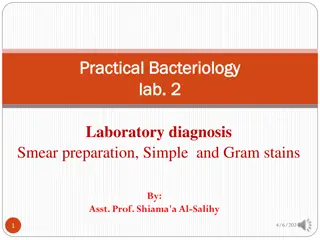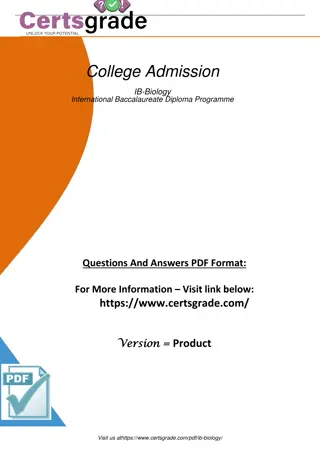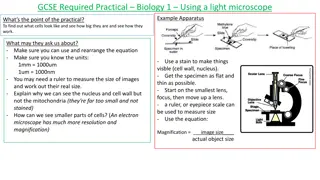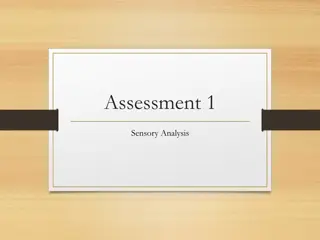Food Tests in Biology Practical
In this biology practical, students test a solution of unknown food substances for starch, protein, reducing sugars, non-reducing sugars, and lipids. They conduct various tests, record observations, and draw conclusions. The preparation of chemical solutions such as Benedict's solution, copper sulfate solution, and iodine solution is detailed. Students also learn how to perform food tests and report their findings. Safety precautions and proper handling of chemicals are emphasized throughout the practical.
Download Presentation

Please find below an Image/Link to download the presentation.
The content on the website is provided AS IS for your information and personal use only. It may not be sold, licensed, or shared on other websites without obtaining consent from the author.If you encounter any issues during the download, it is possible that the publisher has removed the file from their server.
You are allowed to download the files provided on this website for personal or commercial use, subject to the condition that they are used lawfully. All files are the property of their respective owners.
The content on the website is provided AS IS for your information and personal use only. It may not be sold, licensed, or shared on other websites without obtaining consent from the author.
E N D
Presentation Transcript
Biology practical Biology practical (Food Tests) In this practical, students test a solution of unknown food substances for starch, protein, reducing sugars, non-reducing sugars, and lipids. They record their procedure, observation, and conclusions, then answer nutrition and the digestive system. questions about
This section contains the following: Preparation of Chemical Solutions Preparation of Food Solutions Performing the Food Tests Examination Room Student Report Sample Food Test Practical
Preparation of Chemical Solutions Preparation of Chemical Solutions Always make sure the chemicals work before performing the food tests with students. The following are reagents for food test Benedict s Solution This solution can be bought at a chemical store already prepared or you can make it yourself. Using Sodium Carbonate: Add about 1 L of water to a plastic bottle. Add 5 spoons of sodium carbonate (NaCO3). Add 3 spoons of citric acid. Add one spoon of copper sulphate.
Using Bicarbonate of Soda: Using Bicarbonate of Soda: Add 1 L of water to a cooking pot. Add a box (70 g) of bicarbonate of soda. Boil the mixture for 5-10 minutes. This makes sodium carbonate. Let cool and transfer to a plastic water bottle. Add 3 spoons of citric acid. Add one spoon of copper sulphate. Cap and shake to mix. Label as: BENEDICT S SOLUTION FOR FOOD TESTS The solution may be stored in any plastic or glass bottle and will keep indefinitely.
Copper (II) Copper (II) Sulphate Add one spoon of copper (II) sulphate to a 1.5 L bottle. Add 1 L of water and shake until chemicals are fully dissolved. Label as: 1% COPPER (II) SULPHATE SOLUTION FOR FOOD TESTS The solution may be stored in any plastic or glass bottle and will keep indefinitely. Iodine Solution Make sure to use iodine tincture from a pharmacy. The tincture must not contain ethanol/alcohol/spirit. Add 1 part iodine tincture to 10 parts water. Example: In a 500 mL bottle, add 40 mL iodine tincture, then and 400 mL of water. Cap the bottle and shake. Label as: IODINE SOLUTION FOR FOOD TESTS The solution may be stored in any plastic or glass bottle and will keep indefinitely. Sulphate
Dilute Dilute NaOH NaOH Using a PLASTIC teaspoon, add one level teaspoon of NaOH to a 500 mL water bottle. Caustic soda (NaOH) reacts with metal. DO NOT TOUCH. SAFETY NOTE: Prepare about 100 mL of citric acid or ethanoic acid solution to neutralize sodium hydroxide spills on skin or lab tables. One spoon of citric acid in 100 mL of water is suitable. Ethanoic acid solutions are sold in stores as vinegar. Add 250 mL of water.
SAFETY NOTE: This reaction can cause the solution to become very warm. Avoid chemical burns by wearing gloves. Cap well and shake. This makes 1 M sodium hydroxide solution. Label as: 1 M SODIUM HYDROXIDE SOLUTION FOR FOOD TESTS (CORROSIVE) The solution will react with carbon dioxide in the air if not well sealed. Do not store in glass bottles with glass stoppers as these will stick. The solution may be stored in plastic bottles indefinitely.
Dilute Acid Dilute Acid Your school may have dilute hydrochloric acid or you may have to make it yourself. Using Hydrochloric Acid (HCl): Add 1 part HCl to 9 parts water. Example: In a 1.5 L water bottle, add 900 mL of water, then add 100 mL of HCl. Shake well. Using Citric Acid: Add 500 mL of water to a 1 or 1.5 L water bottle. Add 5 spoons of citric acid. Cap well and shake. This makes 0.5 M citric acid. Label as: 0.5 M CITRIC ACID FOR FOOD TESTS The solution may be stored in any plastic or glass bottle and will keep indefinitely.
Sudan III Solution Sudan III Solution Using Sudan III solution takes a long time to show results. It may be replaced by iodine tincture solution for the lipids test. Combine 0.5 g of Sudan III powder with 100 mL of 70% ethanol solution (30 mL water and 70 mL ethanol). Place the solution in a warm water bath to help the Sudan III dissolve. Filter to remove any remaining solid. Label as: SUDAN III SOLUTION FOR FOOD TESTS The solution may be stored in any plastic or glass bottle and will keep indefinitely.
Preparation of Food Solutions For the NECTA and mock exams you may have to set up the food test solutions. The instructions will tell you which ones you will need to prepare in order to make Solution X. Solution X consists of a mixture of at least 3 of the different food substances and is given to each student in at least 3 test tubes. Make sure food solutions are well-dissolved and colorless so that students don t know what is in the mixture. You don t need to measure the ingredients, but make sure to test the solutions before the practical.
Reducing sugar Use glucose powder and dissolve in water. Make sure the substance is fully dissolved so that students don t know what is in the mixture. Non-reducing sugar Use sugar and dissolve in water. Make sure the substance is fully dissolved so that students don t know what is in the mixture. Lipids Mix sunflower oil with water. Shake immediately before use. Sunflower oil is best since it is liquid at room temperature. Protein Mix an egg white with water. Starch Save the water you use to boil potatoes, rice, or pasta. Make sure to remove the bits of food. You can also just mix flour in water, but it would be obvious.
Performing the Food Tests Performing the Food Tests Reducing Sugars Test Add a small amount of Benedict s solution to the food solution. Boil the solution and allow it to cool. Observe the colour changes from blue to green, yellow, then deep orange/brick red precipitate if reducing sugars are present. Always do the reducing sugars test first because a non- reducing sugar will always test positive for a reducing sugar.
Non Non- -reducing Sugars Test reducing Sugars Test Add a small amount of dilute acid (HCl) to the solution. Boil the solution for about 30 seconds and allow it to cool. Add a small amount of NaOH to the solution and shake. Add a small amount of Benedict s solution and boil. Allow the solution to cool and observe as the solution changes from green to yellow, then to deep orange/brick red precipitate if non-reducing sugars are present.
Lipids Test Lipids Test Add a small amount of Sudan III or iodine solution to the food solution and shake. A red ring will form at the top of the test tube if lipids are present. Using Sudan III colours the whole solution red whether it contains lipids or not. Use iodine solution to get a more distinct result. Protein Test Add an equal amount of sodium hydroxide (NaOH) to the solution and shake. Add a small amount of copper (II) sulphate to the solution and shake. Observe the solution turn violet/purple in colour if protein is present.
Starch Test Starch Test Add a small amount of iodine solution to the food solution. Observe the solution turn blue-black in colour if starch is present. Examination Room The NECTA practical exam is done in the school s lab or any other suitable room. Heat sources (jiko, etc.) should be spread evenly in the exam room so that students don t have to go far to heat their test tubes; this also cuts down on cheating. Spread students out and distribute supplies as you see fit.
Each student gets: Each student gets: 3 or more test tubes (to carry out 5 tests) A beaker containing Solution X A test tube rack (or a cut out water bottle with sand to hold the tubes) Students may share the racks, but shouldn t share the cut out bottles Each station should have: Copper II sulphate Water Dilute acid (HCl, etc.) Dilute base (sodium hydroxide) Iodine solution Sudan III solution (can be replaced by iodine solution) Benedict s solution
Student Report Student Report Food test data is recorded in a table containing four columns: Test for, Procedure, Observation and Inference. Students should write the Procedure using the passive voice in the past tense. For example, A small amount of Benedict s solution was added to the solution. Then the solution was boiled and allowed to cool. In the Observation column, the student should write what they observed using the past tense and passive voice. For example, A violet colour was observed.
In the Inferences column, the students should write what they saw in the past tense and passive voice. For example, Reducing sugars were not (or were) present. Note that every column is worth marks on the exam. Even if students fail to do the food tests correctly, they can still get marks for writing what they are testing for and what the procedure should be.
Food Tested Lipids Procedure Observation A red ring did not form at the surface. Inference Lipids were not present. A few drops of Sudan III solution (or solution) were added to solution X. The solution was shaken and allowed to stand. iodine Proteins An NaOH solution X and shaken. A few drops of copper (II) sulphate were added to solution X and shaken again. equal amount added of to A violet colour was observed. Proteins were present. was
Reducing sugars A small amount of Benedict s solution was solution X. The solution was heated and allowed to cool. A small amount of dilute acid was added to solution X. The solution was allowed to cool. Then a small amount of NaOH solution was added, and the solution was shaken. Finally, a small amount of solution was solution was boiled and let cool. A brick red precipitate was observed. Reducing sugars were present. added to Non- reducing sugars The solution changed from green to yellow, then to a deep orange/brick red precipitate. Non-reducing sugars were present. heated and Benedict s added. The
Starch A few drops of iodine solution were added to solution shaken. A blue-black colour was observed. Starch was present. X and
Sample Food Test Practical question Sample Food Test Practical question You have been provided with solution B. Identify the food substances present in solution B by using the reagents provided. Tabulate your work as shown in the following Table: Food Tested Procedure Observation Inference
(a) For each food substance identified in 1(a); i. ii. State their role in the body of human being. (b) The digestion of one of the identified food substance in 1(a) starts in the mouth. i. Name this food substance. ii. Identify the enzyme responsible for its digestion in the mouth. (c) The digestive system of human being has several parts. i. Name the part of digestive system in which most of digestion and absorption of food takes place. ii. Explain how the named part in (d) (i) is adapted for absorption of digested food substances Name two common sources.
NECTA Practical Past Papers 2013 - BIOLOGY 2A (ACTUAL PRACTICAL A) You have been provided with specimens S1, S2, S3and S4. Use the hand lens to observe these specimens then: i. Identify specimen S1, S2, S3and S4by their common names. ii. Classify specimen S1, S2and S3to Class level. Study specimen S1carefully then answer the following questions: i. Draw a neat, large and well labeled diagram of specimen S3. ii. State the habitat of specimen S3. iii. In what ways is specimen S3important to a farmer? State two advantages of specimen S1. State four advantages of specimen S4. Give reason why specimen S4was formally placed in the Kingdom Plantae?
2012 2012 - - BIOLOGY 2A (ACTUAL PRACTICAL A) BIOLOGY 2A (ACTUAL PRACTICAL A) 1. You have been provided with specimens F and G. Study specimens F and G carefully, then: Identify specimens F and G using their common names. Compare specimens F and G, then state their observable differences. Briefly explain the types of germination which occurs in specimens F and G. Using a scalpel, remove the outer coat from specimen F. Split the two parts with the inner sides facing upwards. Then: Draw a well labelled diagram to show the structures of one part of the split specimen F as would be seen from above. For each structure labelled in specimen F, state the role they play in seed germination. Using a scalpel, prepare a longitudinal section of specimen G. Draw a well labelled diagram of the cut surface of specimen G. Identify the part used by specimen G to absorb water during seed germination
2. You have been provided with specimens H, I, J andK. a. Study carefully specimens H and I then: i. Identify specimens H and I using their common names. ii. Suggest the mode of locomotion of specimens H and I. Give reason to support your answer. iii. State the features used to place specimen H in the Kingdom Animalia. b. Use the hand lens to observe specimens J and K then: i. Identify specimens J and K by their common names. ii. Name the habitats for each of specimens J and K. iii. Briefly explain the features which enable specimen H to survive in its habitat. iv. Classify specimens J and K to the phylum level. c. Write down one advantage and one disadvantage for each specimen J and K
2011 2011 - - BIOLOGY 2A (ACTUAL PRACTICAL A) BIOLOGY 2A (ACTUAL PRACTICAL A) 1. The solution prepared contained various food substances. Use the chemicals and reagents provided to identify the food substances present in solution S1. Tabulate your work as shown in the following Table: FOOD TESTED PROCEDURE OBSERVATION INFERENCE
a. State the function in the human body of each food identified in 1(a) above. b. Name two enzymes necessary for digestion of food substance(s) identified in (a) above. c. To each type of food identified above, name at least one source in which the food has been extracted. 2. Study specimen A, B and C then: i. Write common names of specimen A, B and C. ii. Classify specimen A and B to the phylum level. iii. State the habitat and one economic importance of specimen A. iv. Outline four economic importance of specimen B. v. Use the scalpel provided to cut specimen C longitudinally into two equal halves. Then, draw a neat, well labelled diagram of a specimen. vi. Name the division of specimen C. vii. State the observable features you can use to place the specimen into its respective phylum/division.
2010 2010 - - BIOLOGY 2A (ALTERNATIVE A PRACTICAL) BIOLOGY 2A (ALTERNATIVE A PRACTICAL) 1. You have been provided with solution T1. a. Carry out food tests to identify the substances present in solution T1. Record your work in a table as shown below. Test for Procedure Observation Inference
b. What are the functions of the food substances identified in T1in the human body? c. i. State the favorable/suitable pH condition at which the enzymes which digest the food substances present in T1work best. ii. Which of the food substances present in T1is not stored in the human body? iii. What happens when the levels of this substance mentioned in (c) (ii) above, rises in the body?
Classification The classification practical requires students to identify specimens of animals, plants, and fungi. The students must write the common name, kingdom, phylum, and sometimes class of each specimen. They also answer questions about the characteristics and uses of the specimens. This section contains the following:
Common specimens Where to find specimens Storage of specimens Sample practical with solutions Additional classification questions Common Specimens Fungi Mushroom, yeast, bread mold Plants Fern, moss, bean plant, bean seed, maize plant, maize seed, pine tree, cactus, sugar cane, Irish potato1, cypress tree, acacia tree, hibiscus leaf, cassava Animals Millipede, centipede, grasshopper, lizard, tilapia (fish)3, scorpion, frog, tapeworm, liver fluke, cockroach, spider
Where to Find Specimens Where to Find Specimens Start collecting specimens several months before the NECTA exams, as some specimens can be hard to find in the dry season. Ask your students to bring specimens. Students are especially good at finding insects and other animals. You can even find primary school children to gather insects such as grasshopper and millipedes. Ferns, hibiscus, pines, and cypresses are used in landscaping.
Ferns should have sori (sporangia) on the underside of their leaves. Moss often grows near water tanks and in shady corners of courtyards. It is hard to find in the dry season. Sugarcane, Irish potato, cassava, tilapia, bean seeds, and maize seeds can be found at the market. Yeast is available at shops.
Mushrooms are hard to find in the dry season. However, they are available at grocery stores in large cities, and you may be able to find dried mushrooms at the market. You can also collect mushrooms in the rainy season and dry them yourself. Tapeworms and liver flukes may be acquired from butchers. Find out where livestock is slaughtered and ask the butchers to look for worms (minyoo).
Liver flukes are found in the bile ducts inside the liver, while tapeworms are found in the intestines. You can also try going to a livestock fair/market (mnada) or talking to the local meat inspector (mkaguzi wa nyama). Grow your own bread mold. Just put some bread in a plastic bag and leave it in a warm place. But do it ahead of time it can take two weeks to obtain bread mold with visible sporangia
Storage of Specimens Storage of Specimens Insects and mushrooms can be dried and stored in jars. However, they become brittle and break easily. A 10% solution of formaldehyde is the best way of storing specimens. Formaldehyde is often sold as a 40% solution. It should be stored in glass jars and out of the sun. Check specimens periodically for evaporation. Formaldehyde works because it is toxic; handle carefully. In a pinch, a 70% solution of ethanol can also be used to store insects, lizards, and worms. However, specimens sometimes decay in ethanol.
Sample Classification Practical Sample Classification Practical You have been provided with specimens L, M, N, O, and P. Identify the specimens by their common names. Classify each specimen to the phylum level. Further classification: Write the classes of specimens L and M. List two observable differences between specimens L and M. Explain why specimen P cannot grow taller. Write down two distinctive characteristics of the phylum to which specimen O belongs. Reproduction: List the modes of reproduction in specimens M and N. What are two differences between these modes of reproduction?
1. Sample Practical Solutions 1. Sample Practical Solutions Common names of specimens: L: maize plant M: bean plant N: yeast O: millipede P: moss
2. Classifaction by kingdom and phylum Specimen Kingdom Phylym L (maize plant) Plantae Angiospermophyta M (bean plant) Plantae Angiospermophyta N (yeast) Fungi Ascomycota O (millipede) Animalia Arthropoda P (moss) Plantae Bryophyta
3. Further classification: Specimen L (maize plant): Class Monocotyledonae Specimen M (bean plant): Class Dicotyledonae Observable differences: Specimen Vein structure Parallel veins Net veins Root structure Fibrous roots Tap roots L (maize plant) M (bean plant)
The answers to this question should be differences between monocots and dicots that the student can see by observing the plants with their naked eyes. Hence answers such as vascular bundles in a ring are not correct.
4. Specimen P (moss) cannot grow taller because it has no xylem and phloem. If it grew taller, it would not be able to transport food and water throughout the plant. 5. Characteristics of phylum Arthropoda: jointed legs segmented body exoskeleton made of chitin
6. Specimen M (bean plant) reproduces by sexual reproduction. Specimen N (yeast) reproduces by asexual reproduction. Method Asexual reproducti on Genetic variation There is no genetic variation between offspring. Parents Requires one No gametes parent only. are involved. Gametes Sexual There is genetic Usually requires two parents. of two Involves fusion reproducti on variation between offspring. gametes.























